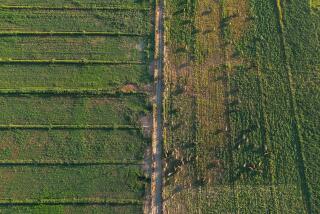Dioxin in Northwest’s Columbia River Threatens Fish, Human Health : Pollution: Paper mills are dumping the toxic compound into the once-pristine river. Oregon is considering limits on the dumping.
PORTLAND, Ore. — The Columbia River drains a Texas-sized corner of northwestern North America, its historically pristine waters rushing to the Pacific Ocean.
Seemingly spared the industrial pollution threatening other great rivers, the Columbia is the heart of a vast and fertile land.
Majestic bald eagles nest along its lower reaches. Salmon fight their way upstream in an annual ritual of renewal.
But all may not be well on the river. Environmentalists, armed with federal studies, say a nearly imperceptible adversary threatens to drain the life out of the Columbia.
The 1989 studies by the Environmental Protection Agency show six pulp and paper mills on the Columbia in Oregon and Washington dump dioxins and related toxic compounds into the river, where they are accumulating in fish in unprecedented amounts.
An EPA official concluded the pollution poses a significant threat to human health and the environment.
The EPA sampled bottom fish in the Columbia. Unlike migratory salmon, bottom feeders, such as carp and sturgeon, spend their lives in the river.
Dioxins, the chemical that caused the evacuation of Love Canal, cause cancer in laboratory animals, and some scientists are questioning studies that so far have found no cancer link in humans. The compounds also persist in soil for years.
Dioxins and other chlorinated organic compounds are byproducts of bleaching wood pulp to make white paper. While many industrial processes produce dioxins, environmentalists say the pulp mills are the greatest offenders on the river.
Based on EPA guidelines, the Oregon Department of Environmental Quality and the Washington Department of Ecology are considering limits on discharges of the most toxic of the dioxins, 2,3,7,8-TCDD of 0.013 parts per quadrillion in water just downstream from the mills. A concentration that low cannot be measured using current technology, so the states would use a mathematical formula to calculate whether the mills are in compliance.
The limits on dioxin discharges are written into permits for the mills, but final action is being delayed by appeals in Oregon, where new permits have been issued. Washington’s Department of Ecology is in the final stages of preparing new permits.
The regional pulp and paper industry says meeting the new standards would be too expensive, $815 million over three years for all the mills in the region. And it says its own study shows dioxin levels that are undetectable or well within U.S. Food and Drug Administration limits. Its conclusion: River fish are safe to eat.
All this is enough to rile people like Mary O’Brien, staff scientist of the Northwest Coalition for Alternatives to Pesticides in Eugene.
“This is the most toxic compound known to humans,” she said. “And if we can’t tell the industry ‘no’ to dumping the most toxic compound known to humans into the river for some superfluous purpose like whiteness of paper, what are we willing to regulate in the world?”
O’Brien’s group, along with Columbia River United, want dioxin discharges eliminated.
“Stop talking to me about how much dioxin is acceptable,” O’Brien said, “and start talking to me about how to get rid of it all.”
Publicly, one of Oregon’s top public health officials, Dr. Laurence Foster, has agreed there is no reason to advise most people to eat less fish.
But privately, in a March 16 letter to Llewellyn Matthews, executive director of the Northwest Pulp and Paper Assn., Foster tore into the industry’s study.
After several months of review, he said, the Oregon Health Division found the study did not support the conclusion that Columbia River fish are safe.
“It would seem the good citizen’s responsibility to do everything possible to prevent future generations from being exposed to ever-increasing body burdens of this toxic chemical,” said Foster, acting health officer and deputy administrator of the Oregon Health Division.
“I encourage you, for the sake of future Oregonians, to do everything possible to stop all discharge of dioxin into the environment.”
In an interview, Foster said he had no comment beyond the letter, made public by John Bonine of the Western Natural Resources Law Clinic at the University of Oregon. Foster added he did not mean to question the good intentions of the industry, only the science upon which the conclusion that the fish are safe to eat was based.
The state eventually plans its own study of the fish.
Industry spokesmen say they are reducing dioxin discharges. But they argue it is unfair to set standards at undetectable levels.
“We’re going to undertake every reasonable effort to reduce,” Matthews said. “We’re shooting for 80%.”
She said environmentalists blow the danger out of proportion. “Dioxin is overrated as a carcinogen,” Matthews said.
Alternatives exist to the chlorine bleaching process that produces dioxins. One mill, the James River mill in Camas, has produced dioxin-free paper as an experiment.
However, industry officials say consumers want the bright white paper produced by chlorine bleaching. They are reluctant to make the expensive transition to alternatives as long as there are doubts about whether consumers will buy the new products.
But that’s not good enough for O’Brien. “These animals just die out silently,” she said. “No one comes around and says, ‘Hey, I’m dying.’ ”
More to Read
Sign up for Essential California
The most important California stories and recommendations in your inbox every morning.
You may occasionally receive promotional content from the Los Angeles Times.










